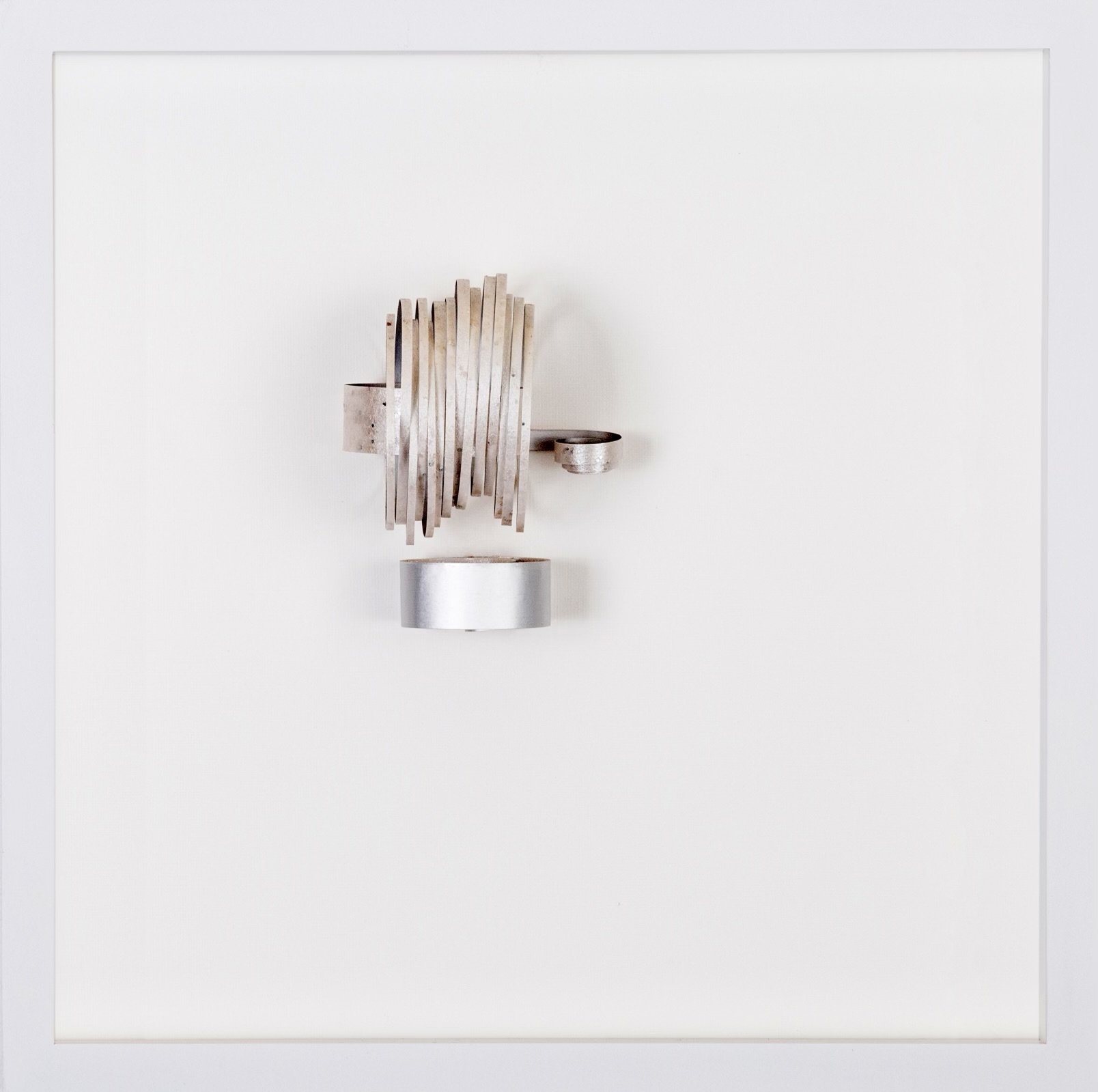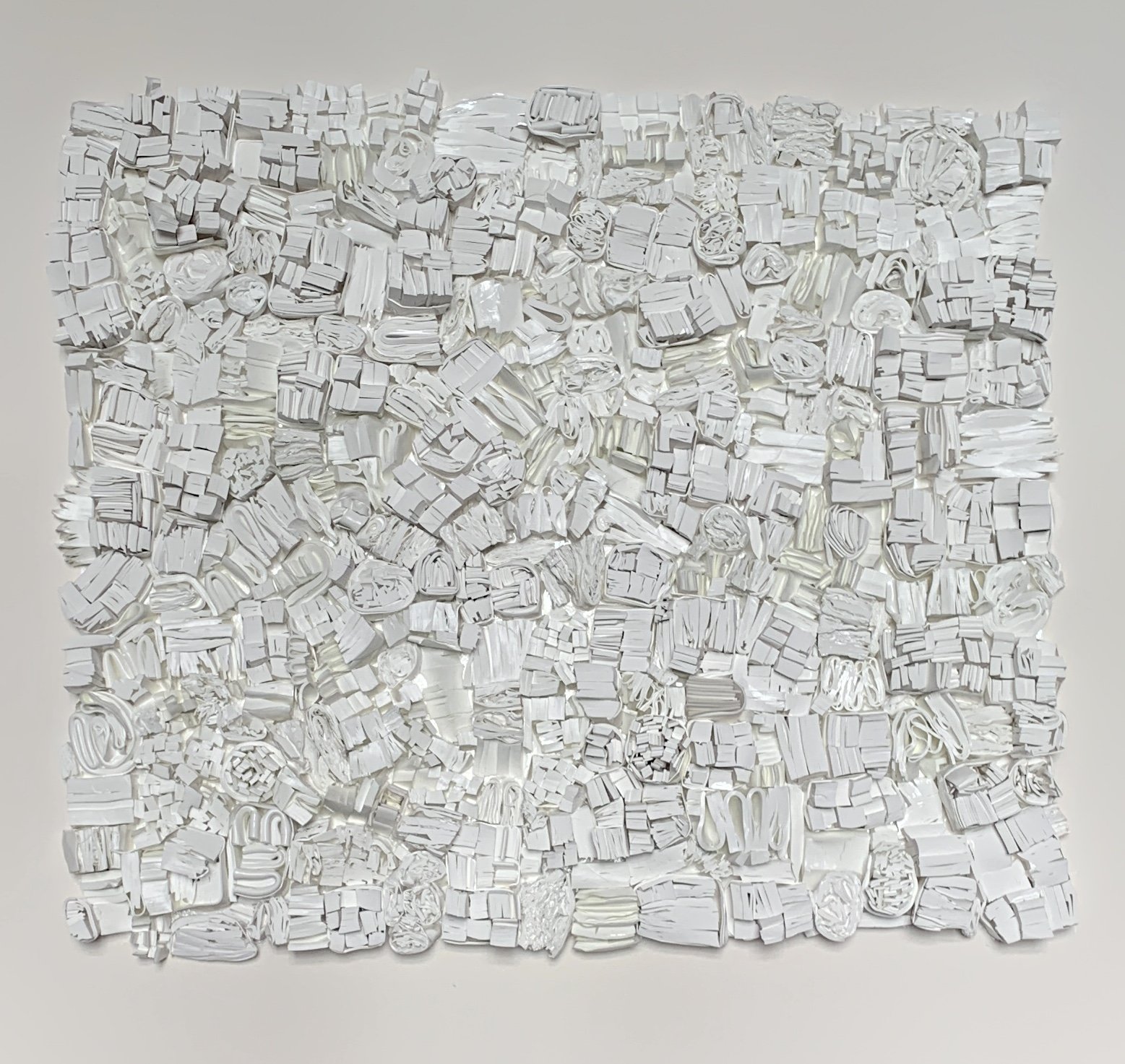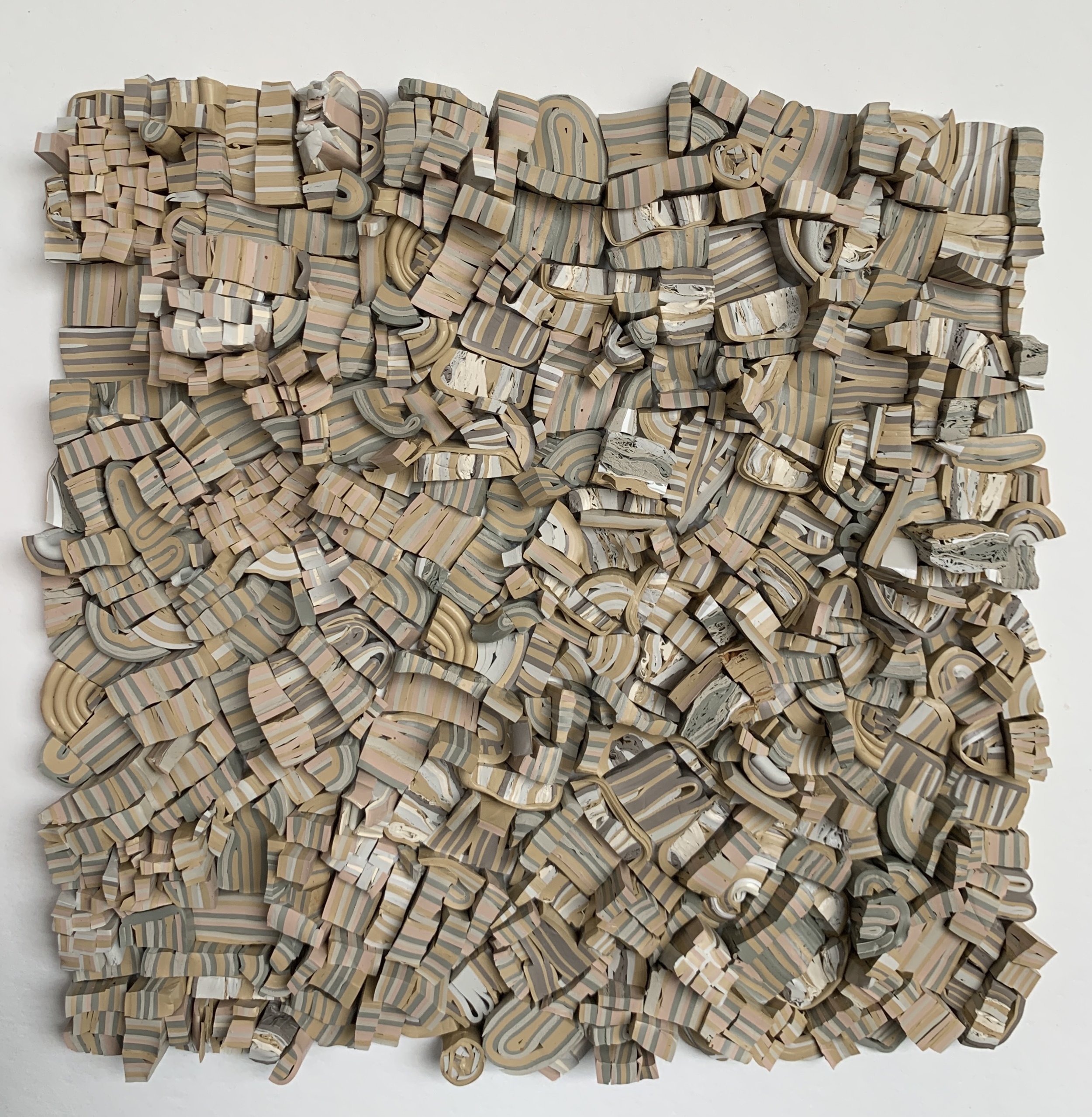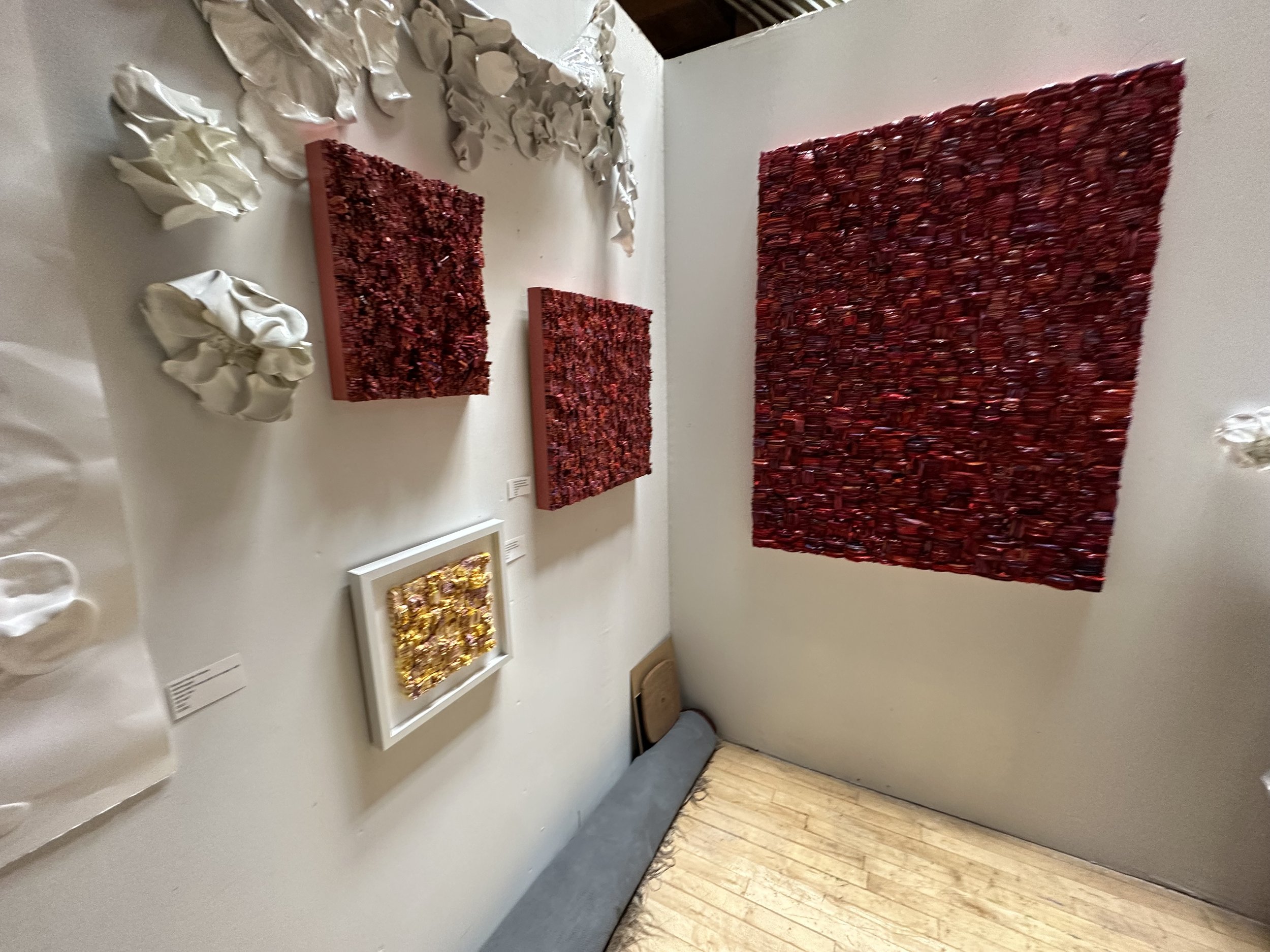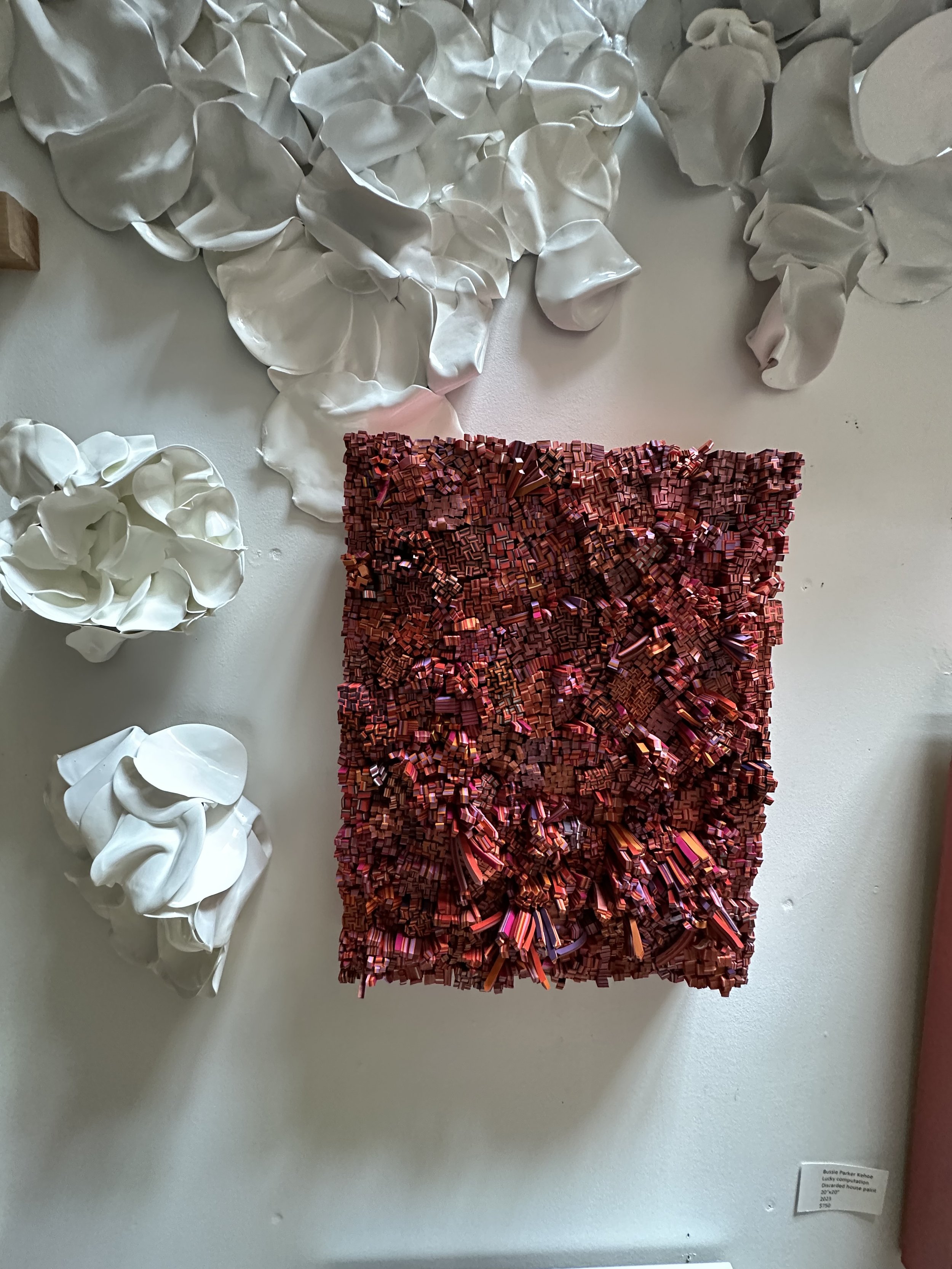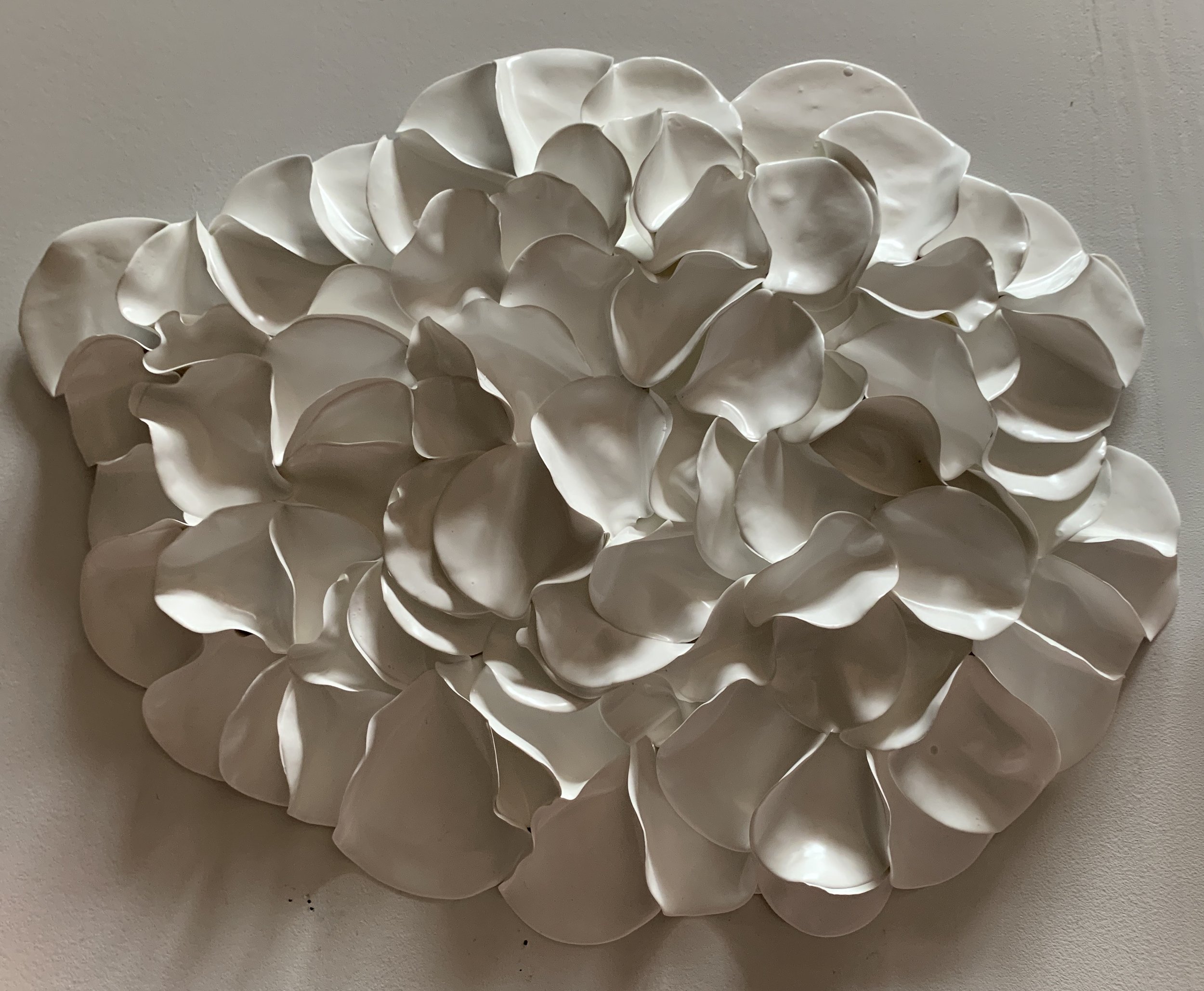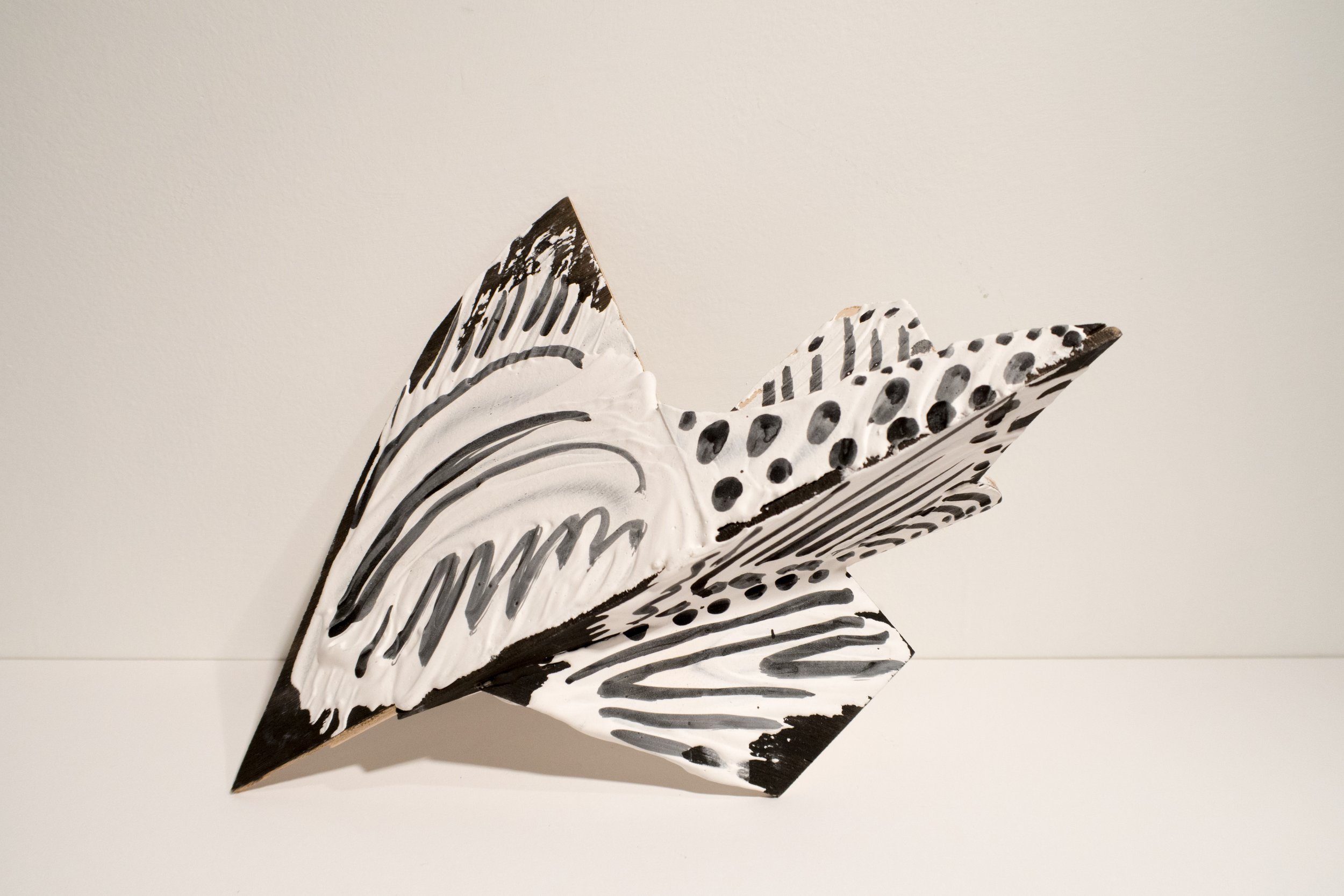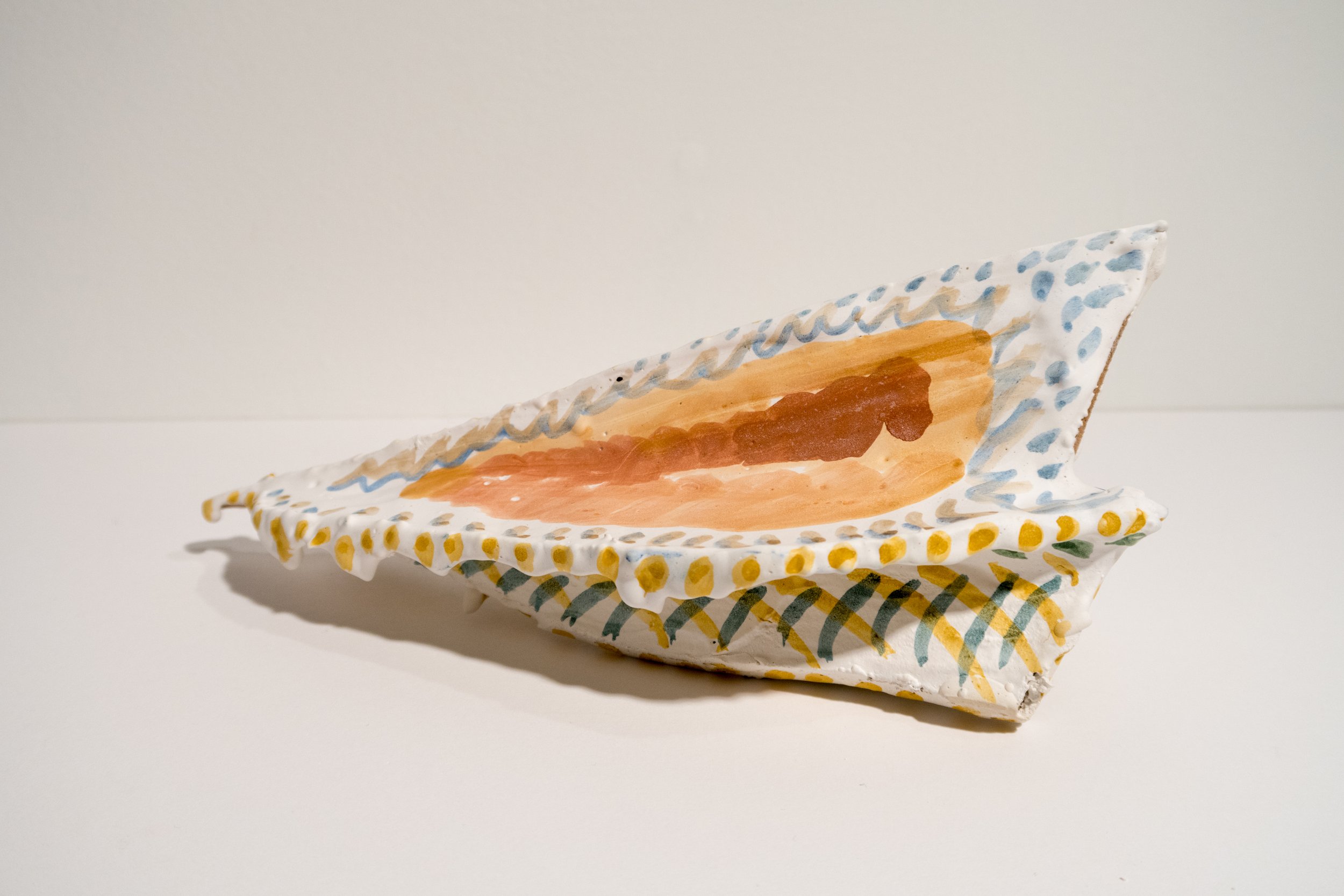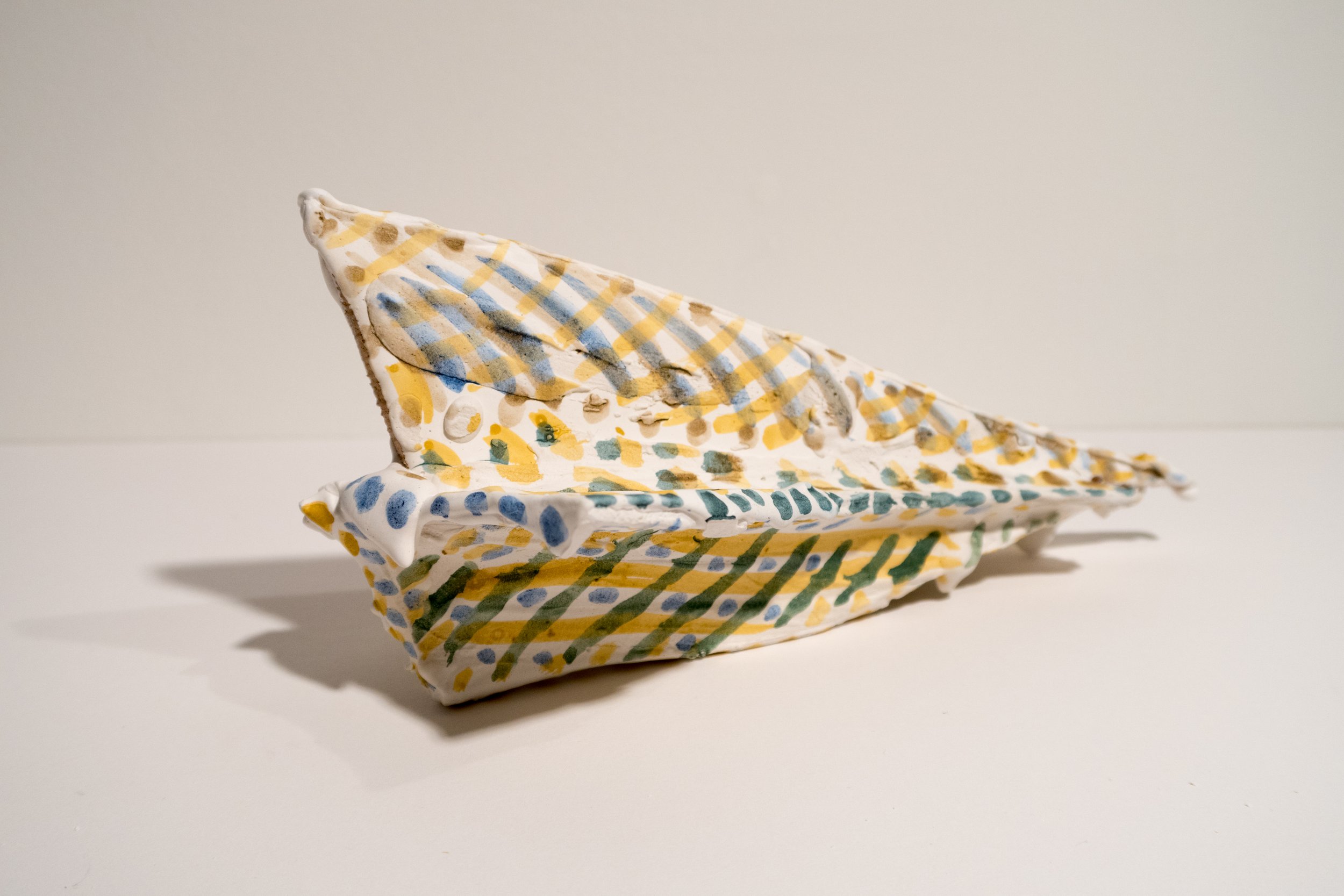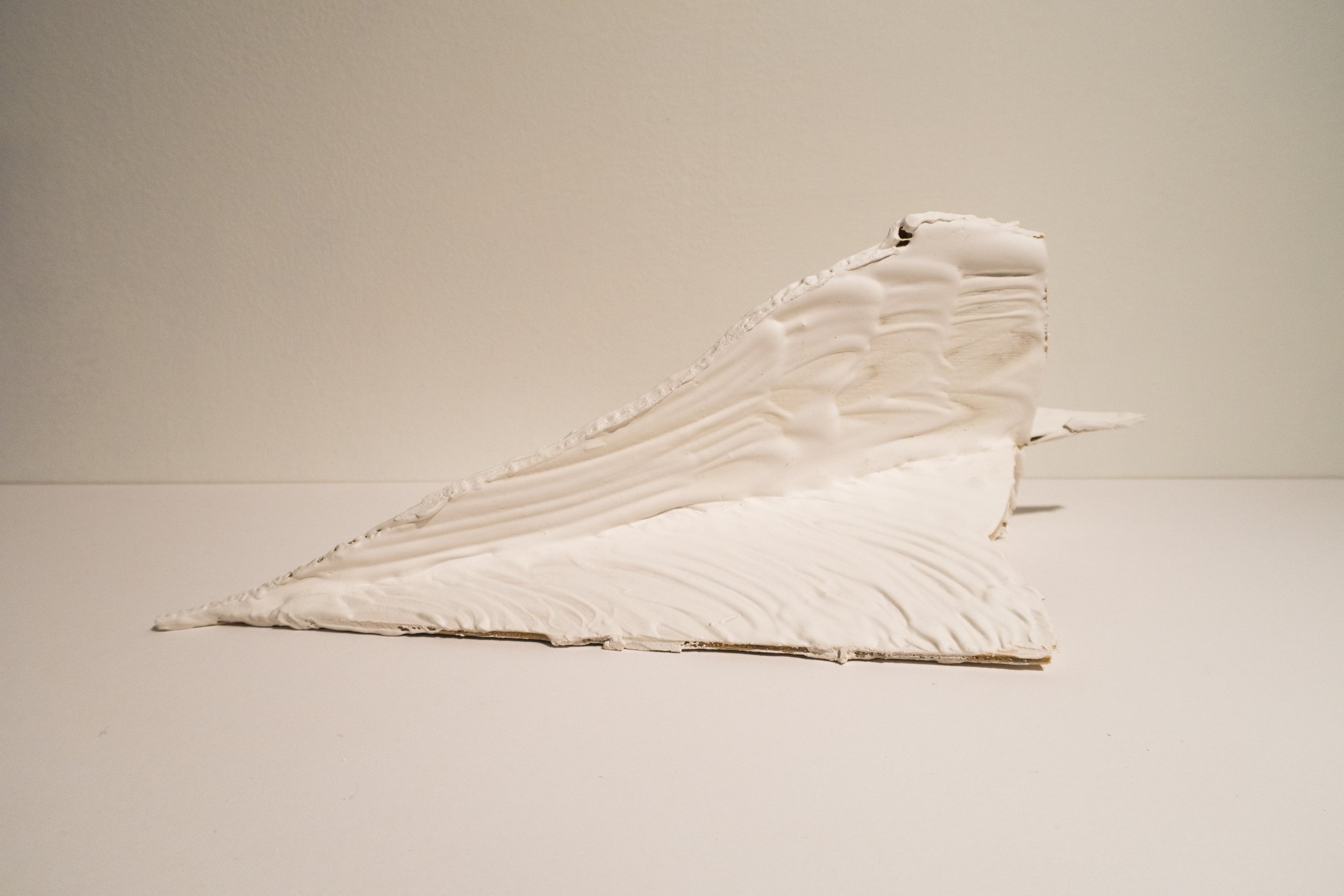CHANGED INTENTIONS
ARTISTS’ TALK, AUGUST 12, 3-4:30 PM
The three artists in CHANGED INTENTIONS, use materials not normally intended for the creation of art. Bussie Parker Kehoe uses rubberlike masses of dried, house paint found at the bottom of paint cans, Denise Laws up-cycles discarded, consumer-good packaging with reflective or stained surfaces and Sarah Smith repurposes leftover construction materials which she surfaces with hydrocal. The artists have created beautiful objects whose materiality represents the possibility and hope of recycling.
Denise Laws
ARTIST STATEMENT
Mylar Reveries Series is my current and ongoing body of work.
I strive to elevate discarded consumer waste by building pieces that reveal the hidden to create meaning and beauty by transforming everyday cast-offs into shimmering baroque futuristic motifs and topographies.
While some artists work in precious metals and gold leaf, the remnants of our current disposable consumerism have become my silver leaf. The surface is essential. Fusion, texture, and an emotional and meditative dialog navigate my decisions, organic shapes, forms, and patterns and indulge in a repetitive, systematic journey to allow and realize an image. I go with what resonates—the agile exquisiteness of nature.
ARTIFICIAL QUARRY, variety of foil-lined packing materials, mica pigment, archival adhesive, UV coating in floater frame
ARTIFICIAL QUARRY, (in different light) variety of foil-lined packing materials, mica pigment, archival adhesive, UV coating in floater frame
TOPOLOGICAL BLUE, 10" X10" X8"
MYLAR REVERIES, TWIGGED, 16" X16" X1.5"
MYLAR REVERIES, RIVULETS, 16" X16" X1.5"
MYLAR REVERIES, RADIUS, , foil-lined packaging archival adhesive on 100%, ragboard under plexiglass, 12" x12" x1"
MYLAR REVERIES, GEMSTONE, , foil-lined packaging archival adhesive on 100%, ragboard under plexiglass, 12" x12" x1"
STAR SAPPHIRE, 10"x10" square with varying depths of 2" -4"
MYLAR REVERIES, ENCIRCLED, , foil-lined packaging archival adhesive on 100%, ragboard under plexiglass, 12" x12" x1"
OF THE FOREST. 10"x10" square with varying depths of 2" -4"
MOTHER OF PEARL, 10"x10" square with varying depths of 2" -4"
TOPOLOGICAL SCENES, DESERT SAND, 12" x12" x1-1.5"
TOPOLOGICAL SCENES, NETTING, 12" x12" x1-1.5"
MYLAR REVERIES, LUCENT, 12" x12" x1-1.5"
MYLAR REVERIES, OPULENCE, variety of foil-lined packing materials, mica pigment, archival adhesive, UV coating in floater frame, 25" x73" x4"
MYLAR REVERIES, REVOLVE, , foil-lined packaging archival adhesive on 100%, ragboard under plexiglass, 12" x12" x3"-5"
MYLAR REVERIES, DECANT, foil-lined packaging archival adhesive on 100%, ragboard under plexiglass, 12" x12" x3"-5"
BUSSIE PARKER KEHOE
Artist Statement
I am a mixed media artist, committed to working with found and discarded materials in meticulous and unexpected ways, transforming the unwanted into something unrecognizable and new. While tinkering, I am processing my feelings, memories, hopes, life experiences, and connection to others; and my art is the language that I use to communicate with others to create a structure of support.
Currently, I pour old discarded house paint onto glass, let the paint dry, then arrange the paint peels in a minimalistic and organic way. I focus on form and structure first—intentionally placing each paint peel so that it connects to and supports the others surrounding it, which is directly related to my life experience of searching for those connections and support. Sometimes, I stack and cut those paint peels, then assemble a “quilt” reminiscent of the Korean textiles that I grew up with. I love the lack of control when pouring juxtaposed with the meticulous placing of the peels. Chaos and order are inherent in this process. It reflects life, where you take what life throws at you and try to make sense of it.
FRISSON, discarded house paint on wood panel, 36" x 48", 2023
GOOD BONES, discarded house paint on Arches paper, mounted on wood panel, 24" x 30", 2022
LUCKY COMPUTATION, discarded house paint on wood panel, 20"x20", 2023
ROGUE GARDEN, discarded house paint on wood panel, 11"x14", 2023
KARL'S NEW SHIRT, discarded house paint on wood panel, 11" x14", 2023
Artist Studio
Artist Studio
PAST AND FUTURE SYMBOLS, discarded house paint and tinted laster on cotton ragboard, framed, 12 x 12, 2022
CARNAVALESQUE, discarded house paint on canvas, 12" x12", 2023
PATCHWORK MADRAS, discarded house paint on cotton ragboard, framed, 12" x 12", 2023
TRUFFLE, discarded house paint on cotton ragboard, framed, 12" x 12", 2023
MINT CHOCOLATE CHIP, discarded house paint on cotton ragboard, framed, 2022
Artist Stuidio
EAT YOUR GREENS, discarded house paint on cotton ragboard, framed, 10" x 10", 2019
SUNFLOWER, discarded house paint on wood scrap, 6" round x 4"diameter.
Artist Studio
Artist Studio
Artist Studio
Artist Studio
5 Irregular white ruffled pieces, part of trailing white truffles around the gallery, approximately 12 x 12, 2023
5 Irregular white ruffled pieces, part of trailing white truffles around the gallery, approximately 12 x 12, 2023
5 Irregular white ruffled pieces, part of trailing white truffles around the gallery, approximately 12 x 12, 2023
5 Irregular white ruffled pieces, part of trailing white truffles around the gallery, approximately 12 x 12, 2023
5 Irregular white ruffled pieces, part of trailing white truffles around the gallery, approximately 12 x 12, 2023
Sarah Smith
ARTIST STATEMENT
Wings, Shells and Shell Collection Collages by Sarah Smith
These sculptures and collages came from a desire to take a break from painting and to explore spontaneity and chance. My art studio has always been a place I go to escape the stresses of my job (I work as a decorative painter and faux finisher in private homes all over the Bay Area) but last year I got into a bit of a rut creatively. I wasn’t painting in my studio anymore and I wasn’t sketching much either. I finally realized I put too many expectations on myself to do great things in my studio after a 40 hour week of painting in other people’s homes. A friend had given me a gorgeous book called, The Shell: 500 Million Years Of Inspired Design - just the astounding title alone sent my mind reeling. I devoured the book and decided to make some shells.
For quite some time I’ve stored boxes of wood scraps and left over off-cuts from previous wood sculptures and installations I made in the past. Moving studios several times necessitated cutting things up and even though a lot got thrown away, some precious boxes of scraps always moved with me. The wings and shells are made from these.
I use a hot glue gun and work quickly assembling my shells and wings with little to no modification to the scraps. Just grab a scrap out of the box, hold it this way or that, don’t worry about making something anatomically correct, accept my decisions on the fly, laugh a little, say why not, apply hot glue and keep going. That’s basically the process. Using the scraps “as-is” was liberating and kept self-doubt at bay.
Coating my sculptures in hydrocal, which is a fast-drying plaster, allows me to give a chalky, dry, bright white look to everything. I use plastic utensils to smooth on the plaster and as it starts to quickly set and harden I use a plastic fork to add texture. I make my own paints for the shells from dry pigments mixed with distilled water and a binder. The homemade watercolors soak into the plaster in such a way that it looks like fresco which I love. Looking at the cubist masterworks of Georges Braque has been a huge inspiration in both the paint application and the attitude I tried to have while making my shells - explore the impression, play around with layers, have fun.
Being so caught up in the joy of making shells I started seeing shell forms in almost everything. The collages come from that sensation. A passing glance at the dried paint on my palette paper revealed shells. Because I’d benefited so much from the spontaneity of making my little sculptures I applied the same attitude to the collages and using scissors I extracted the shell forms from the paint smeared paper without too much concern for scientific accuracy. Once arranged on the background I painted a tromp i’oeil cast shadow as a nod to my dual life as a decorative painter.
Trust momentum and don’t overthink anything - the two rules I embraced for this new body of work. I tried to remove intention from my process. Of course, I knew I ultimately wanted to make a shell or a wing but the process of getting there was like taking a walk in the woods and only looking up at the sky and the branches arching overhead rather than down at the path to avoid stumbling.
WING 5 (large), wood, glue, hydrocal, 18.5" x 8" x 5"
WING 4 (gull), wood, glue, hydrocal, 13" x 5.5" x 4"
WING 3 (vulture), wood, glue, hydrocal, 11" x 5.5" x 4"
WING 1, wood, glue, hydrocal, 11" x 5.5" x 3/4"
WHORLED WHITE SHELL, wood, glue, hydrocal, 15" x 10" x 7"
WHITE SCALLOP SHELLl, wood, glue, hydrocal, 4" X 3" X 1/2"
PICASSO WATERMELON SHELL, wood, glue, hydrocal, paint, 15" x 6" x 5"
PICASSO WATERMELON SHELL, wood, glue, hydrocal, paint, 15" x 6" x 5"
UPSIDE-DOWN BRAQUE SHELL, wood, glue, hydrocal, paint, 12" x 6" x6.5"
SMALL ZEBRA SHELL, wood, glue, hydrocal, paint, 10" x5.5" x3"
SMALL FRESCO SHELL 2, wood, glue, hydrocal, paint, 5.5" x3" x2.5"
SMALL FRESCO SHELL 2, wood, glue, hydrocal, paint, 6" x3.5" x2"
SMALL FRESCO SHELL 1, wood, glue, hydrocal, paint, 5.5" x3" x2.5"
SMALL FRESCO SHELL 1, wood, glue, hydrocal, paint, 5.5" x3" x2.5"
SHELL COLLECTION (Yellow), collage, 8.5" x11"
SHELL COLLECTION (Red), collage, 8" x10
SHELL COLLECTION (PINK), collage, 8.5" x11"
SHELL COLLECTION (LAPIS LAZULI), collage, 24" x18"
SHELL COLLECTION (Yellow), collage, 8.5" x11"
SANDY SHELL, wood, glue, hydrocal, sand, paint, 11.5" x6.5" x2.5"
RED YELLOW BLACK BRAQUE SHELL, wood, glue, hydrocal, paint, 15" x6" x5"
QUEEN CONCH, wood, glue, hydrocal, 15" x8" x5.5"
MUREX SHELL, wood, glue, hydrocal, paint, 12" x10" x1"
MEDIUM ZEBRA SHELL, wood, glue, hydrocal, paint, 11" x5" x4"
LARGE ZEBRA SHELL, wood, glue, hydrocal, paint, 11.5" x9" x4"
LARGE ZEBRA SHELL, wood, glue, hydrocal, paint, 11.5" x9" x4"
GIANT MESSY WHELK, wood, glue, hydrocal, paint, 12" x7" x1.5"
DARK SCALLOP SHELL, wood, glue, hydrocal, paint, 4" x3" 1"
FLAT WHITE SHEEL, wood, glue, hydrocal, 14" x8" x1.5"
GIANT CLAM, wood, glue, hydrocal, paint, 8" x10" x4"
GIANT CLAM, wood, glue, hydrocal, paint, 8" x10" x4"
BLACK SHELL, wood, glue, hydrocal, paint, 10.5" x6" x2.5"
BIG FRESCO SHEEL, wood, glue, hydrocal, paint, 8.5" x4.5" x3.5"
BIG FRESCO SHEEL, wood, glue, hydrocal, paint, 8.5" x4.5" x3.5"
4-PART STROMBUS SHELL, wood, glue, hydrocal13" x 7" x3.5"


















